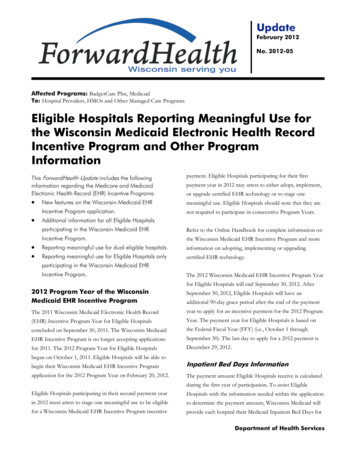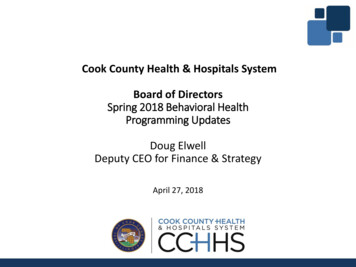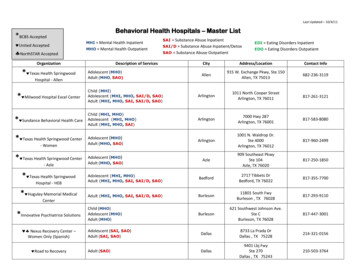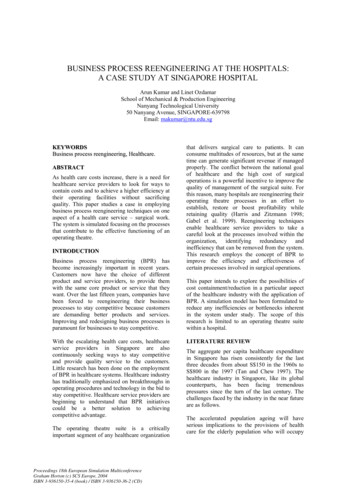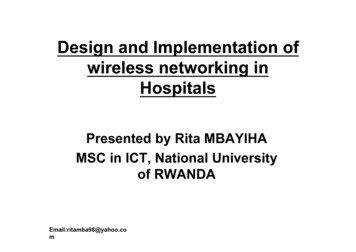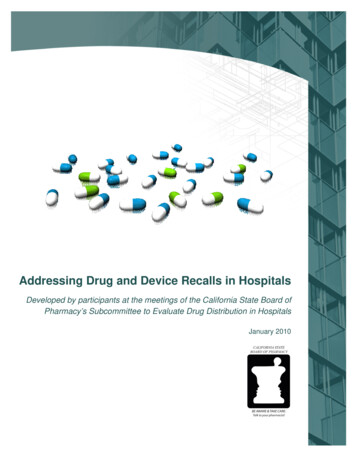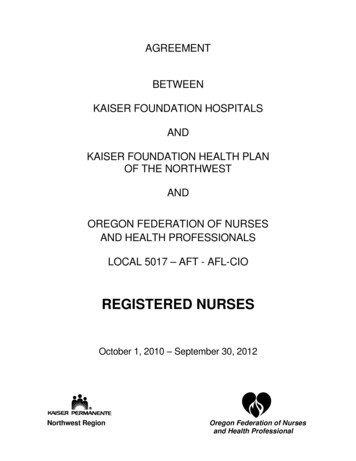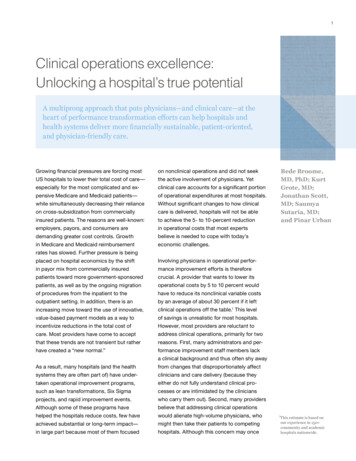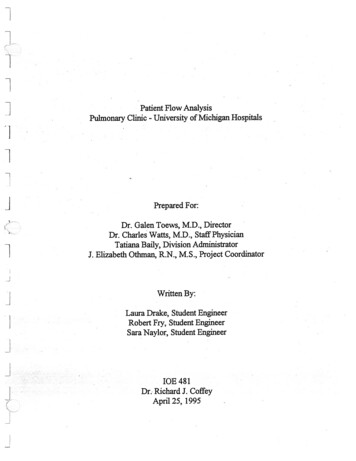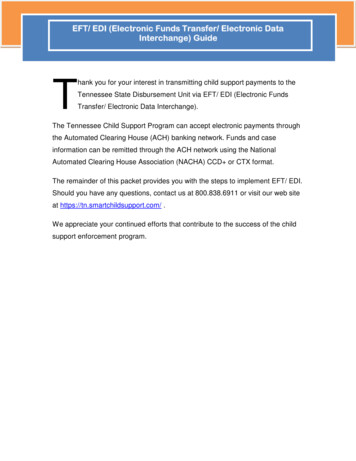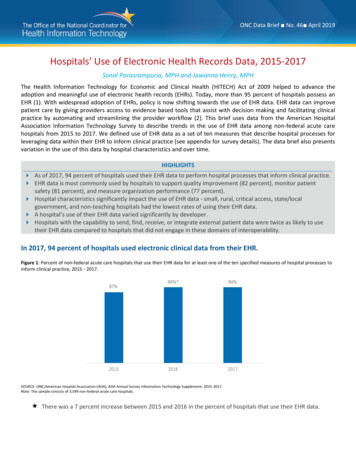
Transcription
ONC Data Brief No. 46 April 2019Hospitals’ Use of Electronic Health Records Data, 2015-2017Sonal Parasrampuria, MPH and Jawanna Henry, MPHThe Health Information Technology for Economic and Clinical Health (HITECH) Act of 2009 helped to advance theadoption and meaningful use of electronic health records (EHRs). Today, more than 95 percent of hospitals possess anEHR (1). With widespread adoption of EHRs, policy is now shifting towards the use of EHR data. EHR data can improvepatient care by giving providers access to evidence based tools that assist with decision making and facilitating clinicalpractice by automating and streamlining the provider workflow (2). This brief uses data from the American HospitalAssociation Information Technology Survey to describe trends in the use of EHR data among non-federal acute carehospitals from 2015 to 2017. We defined use of EHR data as a set of ten measures that describe hospital processes forleveraging data within their EHR to inform clinical practice (see appendix for survey details). The data brief also presentsvariation in the use of this data by hospital characteristics and over time.HIGHLIGHTS As of 2017, 94 percent of hospitals used their EHR data to perform hospital processes that inform clinical practice. EHR data is most commonly used by hospitals to support quality improvement (82 percent), monitor patientsafety (81 percent), and measure organization performance (77 percent). Hospital characteristics significantly impact the use of EHR data - small, rural, critical access, state/localgovernment, and non-teaching hospitals had the lowest rates of using their EHR data. A hospital’s use of their EHR data varied significantly by developer. Hospitals with the capability to send, find, receive, or integrate external patient data were twice as likely to usetheir EHR data compared to hospitals that did not engage in these domains of interoperability.In 2017, 94 percent of hospitals used electronic clinical data from their EHR.Figure 1: Percent of non-federal acute care hospitals that use their EHR data for at least one of the ten specified measures of hospital processes toinform clinical practice, 2015 - 2017.SOURCE: ONC/American Hospital Association (AHA), AHA Annual Survey Information Technology Supplement: 2015-2017.Note: The sample consists of 3,599 non-federal acute care hospitals. There was a 7 percent increase between 2015 and 2016 in the percent of hospitals that use their EHR data.
ONC Data Brief No. 46 April 2019Hospitals commonly used their EHR data to support quality improvement (82 percent), monitorpatient safety (81 percent), and measure organization performance (77 percent).Figure 2: Percent of non-federal acute care hospitals that use their EHR data to perform each process that informs clinical practice, 2015-2017.SOURCE: ONC/American Hospital Association (AHA), AHA Annual Survey Information Technology Supplement: 2015-2017.Note: *Significantly higher than the previous year (p 0.05). The sample consists of 3,599 non-federal acute care hospitals. There was a significant increase in the use of EHR data between 2015 and 2016 for all measures. From 2015 to 2017, the greatest increase in the use of EHR data occurred for identifying high risk patients (15percent increase), identifying care gaps for patients (12 percent increase), developing an approach to query forpatient data (11 percent increase), and supporting quality improvement (11 percent increase). The use of EHR data to develop an approach to query for patient data within a hospital network is the leastfrequent process performed by hospitals from 2015 to 2017 (40 percent, 50 percent, and 51 percentrespectively). Less than 5 percent of hospitals did not use EHR data from 2015 to 2017 to complete any of the 10 processes.ONC Data Brief No. 46 Hospitals’ Use of Electronic Health Records Data, 2015-20172
ONC Data Brief No. 46 April 2019In 2017, hospitals increased their use of EHR data to perform 7 out of 10 processes, on average.Figure 3: Average number of EHR data use processes that hospitals engage in to inform clinical practice, 2015-2017.SOURCE: ONC/American Hospital Association (AHA), AHA Annual Survey Information Technology Supplement: 2015 – 2017.NOTE: *Significantly different from previous year (p 0.05). There are 10 measures of EHR data use to inform clinical practice. The sample consists of 3,599 non-federal acute care hospitals.There are 10 measures of EHR data use to inform clinical practice. In 2017, hospitals used their EHR data, on average, to perform 7 out of 10 processes. Hospitals increased their use of EHR data to inform clinical practice between 2015 and 2016 to an average ofseven of ten processes. There was a significant increase in the average number of uses for EHR data between 2015 and 2016, but nochange between 2016 and 2017.ONC Data Brief No. 46 Hospitals’ Use of Electronic Health Records Data, 2015-20173
ONC Data Brief No. 46 April 2019Small, rural, and critical access hospitals had among the lowest rates of EHR data use to informclinical practice.Table 1: Average number of EHR data use processes that hospitals engage in to inform clinical practice by hospital characteristics, 2015-2017.Hospital SizeSmall (less than 100 beds)Medium/ Large (more than 100 beds)Critical Access HospitalYesNoHospital SystemYesNoGeographic LocationRuralUrbanTeaching StatusTeachingNot TeachingProfit TypeFor ProfitNot for ProfitState/ Local 2SOURCE: ONC/American Hospital Association (AHA), AHA Annual Survey Information Technology Supplement: 2015 – 2017.NOTE: *Significantly higher than the previous year (p 0.05). There are 10 measures of EHR data use to inform clinical practice. The sample consists of 3,599 non-federal acute care hospitals.There are 10 measures of EHR data use to inform clinical practice. In 2017, medium and large hospitals, hospital systems, urban hospitals, and teaching hospitals had the highestrates of EHR data use to inform clinical practice. The greatest increase in the use of EHR data occurred among for-profit hospitals from 3.4 measures in 2015 to7.2 measures in 2017. The smallest changes in the use of EHR data between 2015 and 2017 occurred in small hospitals, hospitals notpart of a hospital system, rural hospitals, and state/local government hospitals. State and local government hospitals’ use of EHR data did not change between 2015 and 2017.ONC Data Brief No. 46 Hospitals’ Use of Electronic Health Records Data, 2015-20174
ONC Data Brief No. 46 April 2019Hospitals’ use of their EHR data varies by EHR developer.Table 2: Percent of hospitals by EHR developer that engaged in each of the metrics of EHR data use to inform clinical practice by EHR developer,2017.Support quality improvement (%)Monitor patient safety (%)Measure organization performance (%)Identify high risk patients (%)Create individual provider profiles (%)Measure unit performance (%)Inform strategic planning (%)Identify care gaps for patients (%)Assess adherence to guidelines (%)Develop approach to query for data (%)None of the above (%)Total Hospitals OURCE: ONC/American Hospital Association (AHA), AHA Annual Survey Information Technology Supplement: 2017.Note: The sample consists of 3,599 non-federal acute care hospitals. “Other developer” encompasses all hospitals that reported using an EHR, but did not use one of the developersmentioned in the table. Examples include: athenahealth, eClinical works, GE, HMS, Health Care System, MED3000, MedWorx, Nextgen, Prognosis, QuadraMed, Sage, Siemens, selfdeveloped, or Vitera/ Greenway. The EHR developers with the highest use of their data to inform clinical practice include Epic, Meditech, andCerner. In 2017, the most used aspect of EHR data for hospitals with Cerner (89 Percent), Epic (96 percent), andMediTech (88 percent) was to support quality improvement. Most hospitals that used CPSI (69 percent), McKesson (74 percent), MedHost (66 percent), or other EHRdevelopers (64 percent) used their data to monitor patient safety. Hospitals with any developer, except Epic and Allscripts, were least likely to use their data to develop anapproach to query for patient data. Hospitals using Epic were least likely to use their EHR data to informstrategic planning and hospitals with Allscripts were least likely to use their EHR data to assess adhere toguidelines. Hospitals using CPSI, Medhost, or one of the unspecified EHR developers were more likely to report that theydid not use their EHR data.ONC Data Brief No. 46 Hospitals’ Use of Electronic Health Records Data, 2015-20175
ONC Data Brief No. 46 April 2019Hospitals that engaged in the four domains of interoperability used their EHR data in substantiallymore ways than hospitals that could not engage in the four domains of interoperability.Figure 4: Average number of EHR data use processes that hospitals engage in to inform clinical practice by hospital interoperability status, 2017.SOURCE: ONC/American Hospital Association (AHA), AHA Annual Survey Information Technology Supplement: 2017.NOTE: *Significantly lower than hospitals that were interoperable for the respective measure (p 0.05). The sample consists of 3,599 non-federal acute care hospitals. There are 10 measuresof EHR data use to inform clinical practice. Hospitals engaged in an interoperability domain (i.e., send, find, receive or integrate) used their EHR data forleast 7 processes, compared to 4 processes for hospitals that did not engage in an interoperability domain. Hospitals that engaged in all four interoperability domains had the highest rates of EHR data use, on average 8.8processes. Hospitals without the ability to send patients’ health information to other hospitals outside theirorganization/system had the lowest use of their EHR data, on average 3.6 processes.ONC Data Brief No. 46 Hospitals’ Use of Electronic Health Records Data, 2015-20176
ONC Data Brief No. 46 April 2019Hospitals participating in CMS Innovation Models had significantly higher rates of EHR data usecompared to hospitals that did not participate in these programs.Figure 5: Average number of EHR data use processes that hospitals engage in to inform clinical practice by participation in Centers for Medicareand Medicaid (CMS) Innovation Models, 2017.SOURCE: ONC/American Hospital Association (AHA), AHA Annual Survey Information Technology Supplement: 2017.NOTE: *Significantly lower than hospitals that participated in the respective CMS payment program (p 0.05). The sample consists of 3,599 non-federal acute care hospitals. There are 10measures of EHR data use to inform clinical practice. Hospitals that participated in quality programs of The Center for Medicare and Medicaid Innovation (CMMI)within the Centers for Medicare and Medicaid Services (CMS) used their EHR data on average in 8 ways,compared to hospitals that did not participate in these programs that used their data on average in 6 ways. Participants of the CMMI Bundled Payment Program had the highest rates, 8.2, of EHR data use to inform clinicalpractice. Hospitals that did not participate in the Accountable Care Organization Model had the lowest rates of EHR datause, 6.3 processes.ONC Data Brief No. 46 Hospitals’ Use of Electronic Health Records Data, 2015-20177
ONC Data Brief No. 46 April 2019SummaryEHRs allow for a more seamless flow of information by leveraging digital technologies that can transform the way thatcare is delivered and compensated (2). EHRs aggregate patient information, such as medical and immunization history,diagnoses, medications, treatment plans, allergies, radiology images, and laboratory and test results, so providers canhave a more complete picture of a patient and make well-informed care decisions quickly (2). This patient informationcan then be used by hospitals to inform their clinical practice patterns to improve care and reduce safety risks (2).Since 2015, the majority of hospitals have used electronic clinical data from their EHR for internal hospital processes thatinform clinical practice. In 2017, 94 percent of hospitals used their data in at least one way. The most common uses ofEHR data in 2017 were supporting a continuous quality improvement process (82 percent), monitoring patient safety (81percent of hospitals), and creating a dashboard with measures of organizational performance (77 percent). EHR data isleast commonly used to develop an approach to query for patient data (51 percent), assess adherence to clinical practiceguidelines (59 percent), and identify care gaps for specific patient populations (60 percent).On average, hospitals used their EHR data in 7 different ways. However, the use of clinical data varied by hospitalcharacteristics. Medium and large hospitals, non-critical access hospitals, hospital systems, non-profit hospitals, teachinghospitals, and those located in urban settings had the highest use of the EHR data. The largest improvements in the useof EHR data over time occurred in for-profit hospitals, which, in aggregate, engaged in 4 additional measures of EHR datause between 2015 and 2017. In general, these hospital characteristics have been associated with early adoption ofhealth information technology and higher rates of interoperability (4). There was also substantial variation in the use ofEHR data by developer. Most hospitals with Epic, Meditech, and Cerner used their EHR data to perform the majority ofprocesses that inform clinical practice, but this did not occur among hospitals with other EHR develo
Hospitals’ Use of Electronic Health Records Data, 2015-2017 . Sonal Parasrampuria, MPH and Jawanna Henry, MPH . The Health Information Technology for Economic and Clinical Health (HITECH) Act of 2009 to advance the helped adoption and meaningful use electronic health records (EHRs)of . Today, more than 95 percent of hospitals possess an EHR (1). With widespread adoptionof EHRs , policy is .File Size: 424KBPage Count: 13
